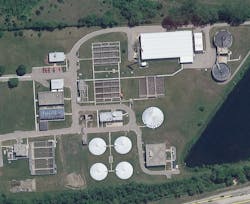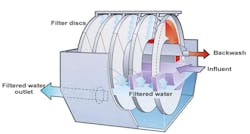Limiting Phosphorus With Disc Filter Technology
About the author:
Jeff Macke is a project engineer at Fehr Graham. He helps clients with master planning, stormwater, water, and wastewater design. He can be reached at [email protected].
The State of Illinois requires certain wastewater treatment plant permittees to complete studies to document the cost and effectiveness of reducing phosphorus concentrations from the plant effluent stream.
Nutrients have come into focus for regulators in the past two decades and states have taken a wide range of approaches to implement new standards. Because of costs that come with wastewater treatment improvements and the complicated process of removing phosphorus, the State of Illinois allows communities to study the cost and practicality of constructing new treatment facilities to reduce phosphorus concentrations.
Fehr Graham completed this study for Crystal Lake, Illinois, in 2020, specifically for its operations at its wastewater treatment plant #2.
Excess Phosphorus Impact on Stream Quality
Illinois will also undergo a more holistic approach to improving stream quality with respect to nutrient concentrations. Excess phosphorus creates a condition in streams called eutrophication that causes algae to grow that deprives the waterbody of oxygen.
Each region or treatment plant permittee will be allowed to study the most cost-effective way to mitigate the impact of excess nutrients in receiving streams. This includes evaluating phosphorus reduction outside the treatment plant process as well as within the treatment process. Communities will even be given the opportunity to demonstrate the stream is healthy and no nutrient reduction is needed.
This approach recognizes the idea that no two plants are alike, and no two streams are alike. Though reducing phosphorus at the treatment plant is the obvious choice, it is not always the most sensible plan for a community and the environment.
Crystal Lake Phosphorus Removal Study
The study reviews the phosphorus removal rates, the ability to reduce concentrations with technology, the removal rate using biological treatment, and the feasibility of reducing phosphorus concentrations using tertiary filters.
Crystal Lake uses chemical treatment at wastewater treatment plant #2 to assist with phosphorus removal. Its required discharge is less than 0.5 mg/L according to its effective permit. Future discharge limits may be as low as 0.1 mg/L. A review of the influent constituency revealed a portion of the phosphorus is very difficult to treat. It takes the form of a soluble non-reactive phosphorus (sNRP) that waste treatment technologies do not remove effectively. The lower limit of treatment can depend on the amount of this phosphorus.
To understand the potential to remove phosphorus from its waste stream, the study involved a pilot test of filter technology.
Disc Filter Technology Pilot Testing
The filter pilot study was conducted with two manufacturers of disc filter systems. Each performed testing on site at wastewater treatment plant #2. Aqua-Aerobics based out of Loves Park, Illinois, and Veolia based out of Cary, North Carolina, mobilized trailers to Crystal Lake’s wastewater treatment plant #2.
Both manufacturers sell disc filter units designed to remove Total suspended solids and particulate Total Phosphorous in the tertiary treatment phase. The filter panel material is woven to a nominal pores size of 10 micrograms. Wastewater flows through a series of discs and the particulates are retained within the filter media, which consists of a polyester woven cloth.
Since the goal for phosphorus removal is below 0.1 mg/L, the use of coagulant and polymer is necessary to flocculate small solids into filterable particulate. The process was deployed by both manufacturers.
The study previously demonstrated a high level of soluble non-reactive phosphorus in prior testing, which can be flocculated and filtered by a mechanism known as, “floc sweeping.” During the flocculation, soluble non-reactive phosphorus can become trapped in hydroxide flocs and removed by filtering media.
The study went through several weeks of testing and the results showed the treatment is effective and can reduce effluent concentrations of Total Phosphorus below the 0.1 mg/L level. There was also reduction below the influent sNRP levels, demonstrating the “floc sweeping” phenomenon was occurring during the pilot testing.
The pilot testing program demonstrated that phosphorus removal down to a concentration below 0.1 mg/L is feasible. Since the current treatment process can remove phosphorus effectively below the limit of 0.5 mg/L, a secondary treatment benefit would be necessary to compel Crystal Lake to invest in the tertiary filter treatment system in the near future.
The potential of the filters to remove barium was explored and reported during the pilot study as well. But the results of the testing showed that barium could be treated more cost effectively by other means.
The final report was delivered to Crystal Lake and submitted to the Illinois Environmental Protection Agency and Fox River Watershed Group. The study will be a valuable asset to the sewer utility as increasingly stringent regulations are enacted.

